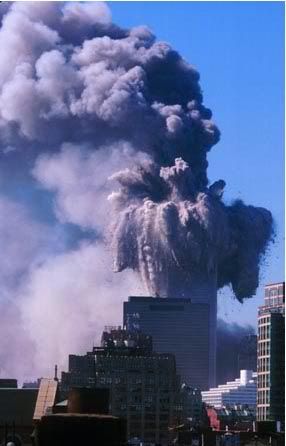first squib going off the allow the top to fall without toppling over and break into pieces.
second squib ejecting to allow the portion above to fall without toppling over and break into pieces

click on pic to play video of witnesses account of hearing bombs
September 12, 2001-February 2002: Witnesses See Molten Metal in the Remains at Ground Zero A chunk of hot metal being removed from the North Tower rubble about eight weeks after 9/11. [Source: Frank Silecchia]
In the weeks and months after 9/11, numerous individuals report seeing molten metal in the remains of the World Trade Center:
Ken Holden, who is involved with the organizing of demolition, excavation and debris removal operations at Ground Zero, later will tell the 9/11 Commission, “Underground, it was still so hot that molten metal dripped down the sides of the wall from [WTC] Building 6.” [9/11 Commission, 5/1/2003]
William Langewiesche, the only journalist to have unrestricted access to Ground Zero during the cleanup operation, describes, “in the early days, the streams of molten metal that leaked from the hot cores and flowed down broken walls inside the foundation hole.” [Langewiesche, 2002]
August 27, 2003: NIST Investigators Rule Out Weak Steel as a Factor in Collapses At the end of a two-day meeting to discuss the progress of their investigation of the WTC collapses on 9/11, National Institute of Standards and Technology (NIST) investigators say that early tests on steel beams recovered from the World Trade Center showed they met or were stronger than design requirements. It also will point out: “Of the more than 170 areas examined on 16 perimeter column panels, only three columns had evidence that the steel reached temperatures above 250�C. ... Only two core column specimens had sufficient paint remaining to make such an analysis, and their temperatures did not reach 250�C. ... Using metallographic analysis, NIST determined that there was no evidence that any of the samples had reached temperatures above 600 �C.”
July 23, 2002: A “lost tape” of radio messages from firefighters inside the WTC on 9/11 is made public. Supposedly, “city fire officials simply delayed listening” to this tape until after the official report on the fire department’s response to the attacks was published, and they still refuse to allow any officials to discuss the contents. The tape reveals that two firefighters were able to reach the crash site on the 78th floor of the South Tower. While there, “Chief Palmer could see only two pockets of fire, and called for a pair of engine companies to fight them.” [New York Times, 9/4/2002; Guardian, 9/5/2002]
Explosive Evidence. The FEMA report titled World Trade Center Building Performance Study, Appendix C (Available at
http://www.fema.gov/library/wtcstudy.shtm) “Limited Metallurgical Examinationâ€, shows evidence of explosives used, by way of photographs, microscopic, and chemical examination. They do not draw this conclusion though. Instead, the authors write (in these selected sentences [The coloring of the text is added here. See below for reason]) “Evidence of a severe high temperature corrosion attack on the steel, including oxidation and sulfidation with subsequent intergranular melting, was readily visible in the near-surface microstructure.â€... “The thinning of the steel occurred by high temperature corrosion due to a combination of oxidation and sulfidation.â€...“The unusual thinning of the member is most likely due to an attack of the steel by grain boundary penetration of sulfur forming sulfides that contain both iron and copper.â€...“A liquid eutectic mixture containing primarily iron, oxygen, and sulfur formed during this hot corrosion attack on the steel.â€... â€
http://911research.wtc7.net/wtc/evidence/metallurgy/










